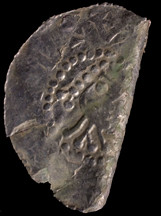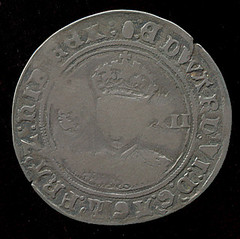
PREV ARTICLE
NEXT ARTICLE
FULL ISSUE
PREV FULL ISSUE
QUERY: EARLIEST USE OF TERM 'WITCH PIECE' SOUGHT
Bob Leonard poses an interesting question about "Witch Pieces". Thanks!
-Editor


Folded coin Having recently purchased a folded coin found at an 11th century “Viking” site in Latvia (images attached), I got to thinking about so-called Massachusetts silver “witch pieces.” In The Pine Tree Coinage of Massachusetts (American Numismatic Society, 1952), Sidney P. Noe wrote (p. 19, also Plate VI, a-c) “We are told that it was the superstitious belief of the time that wearing a bent coin afforded protection against the power of ‘witches.’” Not much authority here! No notice of “witch pieces” is taken by Crosby. Breen (Encyclopedia) adds nothing to Noe's statement. More recently, Will Nipper (In Yankee Doodle’s Pocket, 2008, p. 166) was more skeptical. He wrote, “it often is difficult to separate fact from fiction when studying these pieces.... Many of the survivors were bent and later straightened, leaving a line of extra wear where the bend occurred. Legend says that they were bent as charms against the power of witches, though no contemporary supporting evidence seems to exist for this notion.” Bowers (Whitman Encyclopedia of Colonial and Early American Coins, 2009) appears to have ignored the subject entirely. Louis Jordan, in “The Coins of Colonial and Early America” website, notes that “many Oak and Pine tree shillings [are] wavy and it was assumed they had been bent to protect against witches and later had been straightened out thus leaving a wavy appearance.” However, he writes, “the reason for the bending is that the coins were made on a roller press…. When the coin[s] came out of the two rollers they were not perfectly straight but rather slightly bent. So the bending is due to the coining process not because of the old superstition.” While Jordan is partly correct in that the Oak and large planchet Pine Tree coins were struck on a rocker (not roller) press, making them slightly sinusoidal instead of flat—see Christopher J. Salmon, The Silver Coins of Massachusetts, ANS, 2010, pp. 41-49—this is NOT the cause of the bend marks seen on Noe’s plate, which all have creaselike bends or edge folding. Attached are images of a hammered shilling of Edward VI, 1551-53, which shows somewhat similar flattening after having been creased twice from the reverse. Bent and even folded silver coins, both Islamic and European, are commonly found among Viking hacksilver hoards and single finds from the 9th through the 11th centuries. In particular, silver coins in Polish finds of the first half of the 11th century are mostly found deformed, probably to test the silver quality of unfamiliar German coins, though Łukasz Czwojda (“A Tentative Interpretation of Peck Marks Upon Coins of the Viking Age,” Wiadomości Numizmatyczne LI (183), p. 28), argued that they “cannot be regarded as silver quality tests, [but] expressed the fears that accompanied the users of silver and were supposed to guard them against its negative influence.” Later thin gold coins such as Florentine florins and Venetian zecchinos are also found bent and straightened, as are larger diameter English hammered silver coins. In all these cases, in my opinion, the purpose is to test that the metal is pure enough to withstand bending without cracking or breaking; “witches” are completely out of the picture.


Creased shilling Perhaps I am too cynical, but it is my suspicion that the term “witch piece” was invented by a coin dealer trying to get more money for a mutilated coin, and has no actual basis in history. Does anyone know when the term first appeared in an auction catalog or price list, and what authority—if any—was offered?
Great question. I always took that tale as a given and never questioned it. I'm glad Bob did. What do readers think? Can anyone locate an earlier reference, or offer up additional evidence on either side of the topic?
-Editor
To read the Louis Jordan web page, see:
FAQ: Witch Pieces
(www.coins.nd.edu/ColCoin/FAQ/witchpieces.html)
The Numismatic Bibliomania Society is a non-profit organization promoting numismatic literature. See our web site at coinbooks.org. To submit items for publication in The E-Sylum, write to the Editor at this address: whomren@gmail.com To subscribe go to: https://my.binhost.com/lists/listinfo/esylum All Rights Reserved. NBS Home Page Contact the NBS webmaster 
|